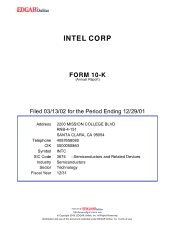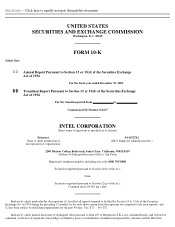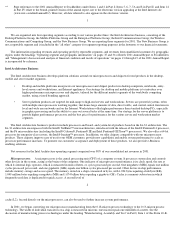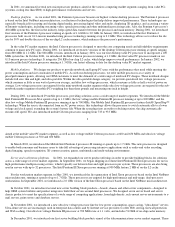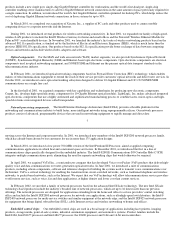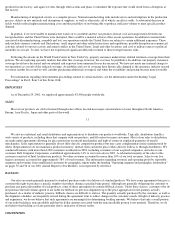Intel 2001 Annual Report Download - page 11
Download and view the complete annual report
Please find page 11 of the 2001 Intel annual report below. You can navigate through the pages in the report by either clicking on the pages listed below, or by using the keyword search tool below to find specific information within the annual report.
produced in one factory, and again we seek, through other actions and plans, to minimize the exposure that would result from a disruption at
that factory.
Manufacturing of integrated circuits is a complex process. Normal manufacturing risks include errors and interruptions in the production
process, defects in raw materials and disruptions at suppliers, as well as other risks, all of which can affect yields. A substantial decrease in
yields would result in higher manufacturing costs and the possibility of not being able to produce sufficient volume to meet specific product
demand.
In general, if we were unable to manufacture wafers or to assemble and test our products abroad, or if air transportation between our
foreign facilities and the United States were disrupted, there could be a material adverse effect on our operations. In addition to normal risks
associated with manufacturing, assembly and test, our operations outside the United States are subject to certain additional exposures. These
risks include currency controls and fluctuations; tariff, import and other related restrictions and regulations; possible disruption in commercial
activities related to terrorist activity and armed conflict in the United States, Israel and other locations; and civil or military unrest or political
instability in a locale. To date, we have not experienced significant difficulties related to these foreign business risks.
Following the attacks on the World Trade Center in New York City, property insurance underwriters deleted terrorism coverage from their
policies. We are exploring specialty markets that offer this coverage, however, the cost may be prohibitive. In addition, our property insurance
coverage levels have decreased and our retained risk exposure from uninsured losses has increased. We have not made any material change to
our operations as a result of the reduced coverage. Availability and cost of coverage have historically changed as the insurance industry reacted
to various market forces and we will consider purchasing additional coverage if and when the availability and pricing become more favorable.
For information regarding environmental proceedings related to certain facilities, see the information under the heading "Legal
Proceedings" in Part I, Item 3 of this Form 10-K.
EMPLOYEES
As of December 29, 2001, we employed approximately 83,400 people worldwide.
SALES
Most of our products are sold or licensed through sales offices located near major concentrations of users throughout North America,
Europe, Asia-Pacific, Japan and other parts of the world.
11
We also use industrial and retail distributors and representatives to distribute our products worldwide. Typically, distributors handle a
wide variety of products, including those that compete with our products, and fill orders for many customers. Most of our sales to distributors
are made under agreements allowing for price protection on unsold merchandise and right of return on stipulated quantities of unsold
merchandise. Sales representatives generally do not offer directly competitive products but may carry complementary items manufactured by
others. Representatives do not maintain a product inventory; instead, their customers place orders directly with us or through distributors. We
conducted business with more than 2,000 customers worldwide in 2001, including customers of our acquired companies, and sales to one
customer, Dell Computer Corporation, contributed approximately 14% to our total sales in 2001. A substantial majority of the sales to this
customer consisted of Intel Architecture products. No other customer accounted for more than 10% of our total revenues. Sales to our five
largest customers accounted for approximately 38% of total revenues. The information regarding revenues and operating profit by reportable
segments and revenues from unaffiliated customers by geographic region under the heading "Operating segment and geographic information"
on pages 35 and 36 of our 2001 Annual Report to Stockholders, is incorporated by reference.
BACKLOG
Our sales are made primarily pursuant to standard purchase orders for delivery of standard products. We have some agreements that give a
customer the right to purchase a specific number of products during a specified time period. Although not generally obligating the customer to
purchase any particular number of such products, some of these agreements do contain billback clauses. Under these clauses, customers who do
not purchase the full volume agreed to are liable for billback on previous shipments up to the price appropriate for the quantity actually
purchased. As a matter of industry practice, billback clauses are difficult to enforce. The quantity actually purchased by the customer, as well as
the shipment schedules, are frequently revised during the agreement term to reflect changes in the customer's needs. In light of industry practice
and experience, we do not believe that such agreements are meaningful for determining backlog amounts. We believe that only a small portion
of our order backlog is noncancellable and that the dollar amount associated with the noncancellable portion is not material. Therefore, we do
not believe that backlog as of any particular date is indicative of future results.
COMPETITION

